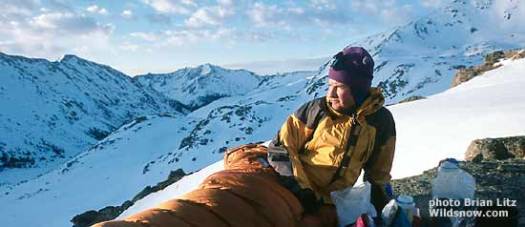Skiing the Trooper Traverse, Colorado Historical 10th Mountain Division Route — Feature Article
See all Lou Dawson’s and WildSnow’s Trooper Traverse content.
Editor’s note from Lou:It was decades ago when Chris Clark, Brian Litz and myself re-created the original 10th Mountain Division soldier’s “Trooper Traverse” from Leadville, Colorado to Aspen. Since then the route has become popular; skied several times each spring. Please enjoy my brief description of the trip, and go ski it! Also, check out a very personal account of this trip in my memoir, Avalanche Dreams. There was more too it than skiing.
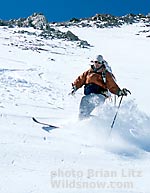
Chris Clark high on the Trooper Traverse, 2001.
It’s the year 2000. We’re at 12,400 feet elevation on a 40-mile ski mountaineering and backcountry skiing trip from Leadville, Colorado to Aspen, retracing the steps of thirty-three 10th Mountain Division soldiers who skied this same traverse in February of 1944. They were training for World War II and most shipped to Europe soon afterward. Some never returned. Though they probably didn’t realize it, the soldier’s “trooper traverse” ended up being one of the most forward-thinking and aggressive ski traverses ever done in North American mountaineering.

Trooper Traverse takes the highest ground in Colorado, including the Continental Divide shown here.
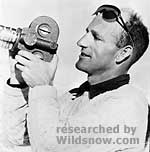
Captain John Jay went on to found the modern ski film industry. Photo from Denver Public Library Western History Collection, used by permission.
Led by Captain John Jay, father of modern ski films, and Sergeant Paul Petzoldt, the man who pioneered modern outdoor education via the National Outdoor Leadership School, the troopers made what appears to be a flawless four-day winter journey over Colorado’s highest peaks.
Around 1990, while I was writing a guidebook for Colorado’s 10th Mountain Hut System, 10th veteran (and hut system founder) Fritz Benedict gave me a few pages from a 1944 Camp Hale Ski-Zette, a newspaper printed for the 11,000-plus soldiers stationed at Camp Hale. A short article in the paper described “one of the most ambitious ski marches ever attempted by mountain troopers…” This would come to be called “The Trooper Traverse,” skied by 33 10th Mountain Division soldiers in 1944. A few years after Fritz made me aware of the soldier’s trek, along with two friends I re-created the trek.

The Camp Hale Ski-Zette of Friday, March 3, 1944, published an article about the trooper traverse.
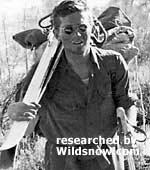
10th Mountain trooper Ralph Ball hiking into Aspen during 1944 traverse.
………….
I meet my partners on a warm day in May of 2001, near Leadville, Colorado. Brian Litz, photographer and backcountry ski journalist, is the perfect companion–positive, skilled, and passionate about Colorado backcountry skiing. His friend Chris Clark, a man of few words and plentiful smiles, is super fit and psyched for something special.
The first six miles of uncertain travel goes quickly. We camp where the soldiers spent their first night, in the last trees beneath Mount Elbert, Colorado’s highest mountain.
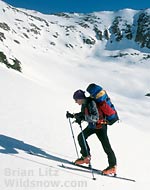
The author on day 2, heading to Darling Pass from Champion Mill.
We start before dawn on day two. The only route information I have is from the Ski-Zette, which says the soldiers crossed the “Champion-Deer Mountains Pass.” According to the map, this could be one of several places. My plan is to rely on our mountaineering judgment and the photos I’d researched, and pick what we feel is the best route — rather than blindly following where we guess the soldiers might have gone. Later, when I compared additional photos, it was easy to identify our route as that taken by the soldiers. Their choices and ours connected us across the gulf of time.
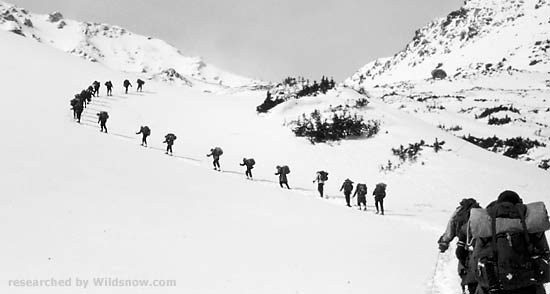
The troopers approach Darling Pass in 1944.
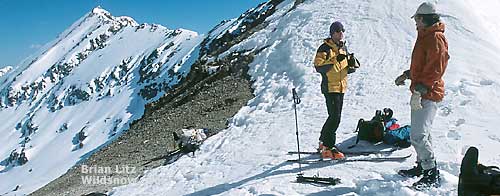
On Darling Pass, Deer Mountain on left horizon.
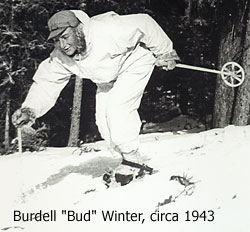
Private Bud Winter died fighting in Italy. I dedicated this trip to him. Family archive photo used by permission.
We make turns down from Darling Pass. While resting in the valley below, I think again of the troopers. One in particular, Burdell “Bud” Winter, joined the 10th when he was 18 years old, trained at Camp Hale in 1944, and must have stood near this exact spot, looking back up at his tracks, perhaps laughing in joy with his friends. By all accounts, young Private Winter was one of the strongest on the trip, breaking much of the trail in deep February snow. A few months later Bud Winter shipped to Italy. He did not come home.
After a long rest in the valley, we climb in hot sun and slushy snow, the Continental Divide looms above us like the ramparts of a distant castle. Chris takes the lead and disappears behind a spur. Brian and I wonder where he’ll stop, we need to camp soon.
Panting like wrung out dogs, we follow the track Chris has made through the slush. Soon we crest a rise. This has to be the place, otherwise we’ll be climbing over 13,000-foot ridges in the dark. And yes, there is Chris. Shucking my skis, I realize this hunk of granite forms what is perhaps the best campsite I’ve ever had in 30 years of mountaineering. We are at 12,000 feet elevation in the middle of the Rocky Mountains — we could have been on smooth asphalt in Miami.
As if fashioned with three exhausted skiers in mind, the place is replete with chair-back shaped knobs and perfectly flat beds. Above us, spring snow with elegant melt patterns leads above us to the Continental Divide.
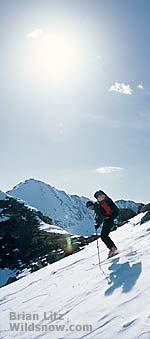
Author skiing from Continental Divide, Deer Mountain in background.
The next day, at the head of Lost Man Creek we’re perched above the best run of the trip, two miles of perfectly angled corn, ripe for harvest. We ski with abandon, skating traverses to set up for small fall-line drops.
Ahead, the Williams Mountains. We pick a line of lesser resistance, but nonetheless find ourselves perched above a steep couloir. As we descend this most radical terrain of the trip, I mention to Brian my doubts about the soldiers having gone this way. I later find out they had.
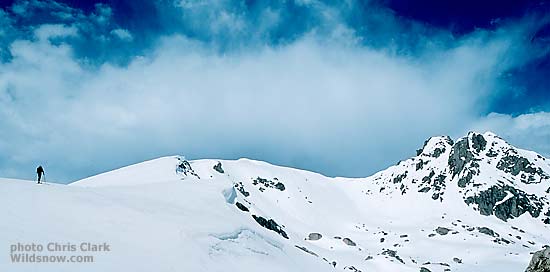
Heading west up the avalanche safe ridge to the Williams Mountains. Trooper Couloir is on other side of obvious saddle.
In the Hunter Creek valley, we find a patch of dry ground, build a campfire, and cook our last freeze-dried dinner. As the coals glow the forest embraces us in spring optimism. Our problems shrink, the future seems bright and filled with promise.
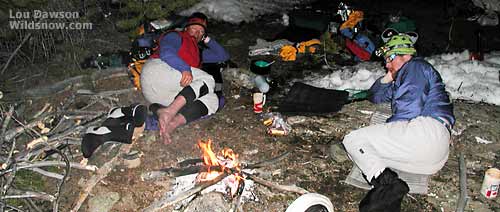
Multi-day trips allow a kind of fellowship you don’t get during fast day tours. Add camping to the mix, and the camaraderie is sweet. Did the troopers get some of the same? I like to think so…
Our last morning arrives with clouds. Just as the soldiers did, we make a beeline for Aspen and the Hotel Jerome, where we quaff Aspen cruds (burbon milkshakes) and bake in the burn of an outstanding backcountry ski trip.

Brian Litz stands in the door of Hotel Jerome, 2001. To right is Jerome in the late 1940s after war.
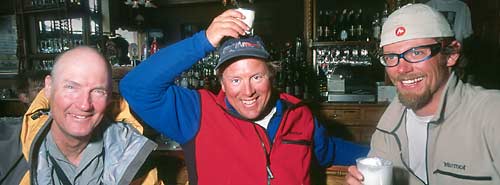
Toasting the troopers at Hotel Jerome, in a style we’re sure they’d appreciate, Aspen Crud in hand. L to R: Lou, Brian, Chris.
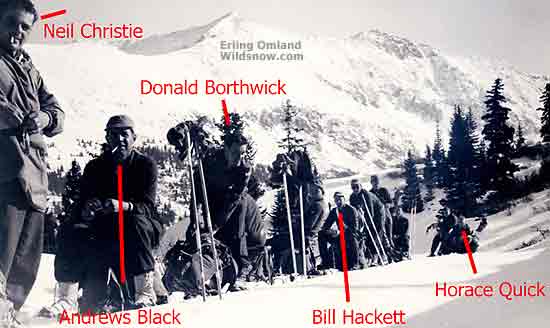
Most of the original 1944 troopers in Hunter Creek, probably on their last day. Trooper Couloir to right just out of photo.
Index for all Trooper Traverse content at LouDawson.com and WildSnow.com.
